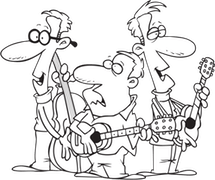
Repertoire – the songs we play and how we play them. A song is a vehicle of self-expression. So whether playing your songs or other people's songs. It's all about the song.
There are four elements of a repertoire regardless of your chosen instrument capability. And, our beloved Ukulele is on the those instruments that is capable of doing all four.

Melody
A Melody is a sequence of musical notes or tones that are perceived as a single, cohesive, and memorable line of music. It is the principal and often the most recognizable element of a musical composition. Without the melody, anyone would be hard-pressed even to identify what song it is.
A Melody can be previously composed or improvised on the spot.
Melodies can be found in all styles of music, including classical, pop, jazz, folk, and more. They can be sung by a vocalist, played as an instrumental, or even generated electronically in the case of synthesized and computer music. Melodies are the heart and soul of a musical piece, guiding the listener through its narrative and creating a connection.
Learn melodies – no one goes around whistling chord progressions..— Joe Pass
Background or Accompaniment
Comping – short for accompaniment is simply the music and instruments that are accompanying
the melody. These are the chords, a.k.a, the chord progression that supports the melody. Typically a term used by jazz musicians and done by the musicians playing an instrument capable of playing chords, harmonically, ie: multiple notes at a time. The ukulele, just as the guitar and piano is one such instrument.
Players use their chord knowledge and rhythmic sense to create effective accompaniments for melodic instruments, singers, and improvisers.
Unlike the melody this is typically not written out or notated beyond a simple leadsheet often including chord symbols and must be worked out ahead of time or improvised on-demand in the required style of the performance.
Improvisation
Improvisation or "improv" is the art of creating spontaneous melodies, i.e., solos, licks, and riffs. The ability to solo over the changes – the chord progression.
Improvisation has been a hallmark of jazz and blues and draws from four sources: scales, arpeggios, intervals, and sequences. What brings a lot of musicians to these styles is this improvisational aspect. The spontaneous composition or at times, combustion, at times of creating music on the fly. A true musical high wire act at times.
Many novice performers often feel discouraged when confronted with the task of mastering "scales." Some might have a basic understanding of a scale or two but encounter challenges when attempting to translate that knowledge into musical expression. There's a sense of enigma or enchantment surrounding the origins of ideas for these impromptu melodies and licks. When you factor in the complexities of finger placement and the various possible note positions, it's no surprise that players find improvisation to be a formidable endeavor.
Melody and Chord
Chord Melody or Melody and Chord is the art of playing the melody and chords at the same time. Solo piano players do this all the time. They have two hands to do it. On the ukulele, we have to do it all with one hand and only four strings. In the common high G, C tuning, the available range of notes for creating melody and chord arrangements on a ukulele is around two octaves, give or take a few notes. A little more on the lower end for a low G, C tuning.
Most Jazz
piano and guitar players will tell you this is the most challenging aspect of performing and learning to play — Jazz
.
This is the technique of combining the chords and melody of a song or composition. It is unique to jazz and ultimately requires an extensive chord vocabulary and a firm grip on harmony – the how of chords work together, what substitutions, additions, embellishments, etc can be applied.
Learn the repertoire. It's all in the songs. If you learn 200 songs, you will have no problem improvising.— Frank Vignola
NOTE: Right here on LearningUkulele.com and Learning Ukulele with Curt, the Songs section contains a lot of Curt's melody and chord arrangements in various jazz, blues and other styles. All available to view, download and used as a reference to create yous own arrangements.
A Sample of Songs in the Jazz
Style Available on LearningUkulele.com
Here are links to jazz and jazz influenced songs & play-along tracks right here on LearningUkulele.com.




.jpg)